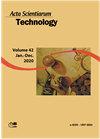Physicochemical characteristics and bioactive compounds of three puçá (Mouriri pusa Gardner) varieties, an underexploited fruit from the Brazilian Cerrado
IF 0.6
4区 综合性期刊
Q3 MULTIDISCIPLINARY SCIENCES
引用次数: 0
Abstract
Puçá fruits are native to the Cerrado biome yet little explored, presenting different varieties with distinct fruit peel colors. Although puçá fruits have been known to exhibit a good source of bioactive compounds, the phenolic profile of some varieties remains unknown. Based on this context, our research aimed to evaluate the chemical composition and bioactive compounds and characterize for the first time the phenolic profile in yellow puçá, brown puçá, and black puçá by high-performance liquid chromatography coupled with diode array detection (HPLC–DAD). The three puçá varieties contained considerable quantities of important food constituents, such as high concentrations of vitamin C, carotenoids and phenolic compounds. These fruits are mostly composed of phenolic acids, with p-coumaric acid being the major compound in all varieties, while ellagic acid was detected only in the brown puçá. Moreover, (−)-epicatechin was found only in the yellow puçá. This study is the first to report the identification of the phenolic profile in puçá. Moreover, our data indicate that the three fruit varieties present a promising chemical composition, suggesting that they may serve as potential sources of natural antioxidants. In addition, these findings can contribute to the establishment of puçá as a novel ingredient for formulations with functional claims.来自巴西塞拉多的一种未充分开发的水果,三个pu (Mouriri pusa Gardner)品种的理化特性和生物活性化合物
pup 水果原产于塞拉多生物群系,但很少被探索,呈现出不同的品种,不同的果皮颜色。尽管已知pu 水果具有良好的生物活性化合物来源,但某些品种的酚类成分仍不清楚。在此背景下,本研究旨在利用高效液相色谱-二极管阵列检测(HPLC-DAD)技术,对黄浆、棕浆和黑浆的化学成分和生物活性成分进行评价,并首次对其酚类成分进行表征。这三种椰 品种含有相当数量的重要食物成分,如高浓度的维生素C、类胡萝卜素和酚类化合物。这些果实主要由酚酸组成,其中对香豆酸是所有品种的主要化合物,而鞣花酸仅在棕色果肉中检测到。此外,(−)-表儿茶素仅存在于黄色浆中。本研究首次报道了pup 中酚类成分的鉴定。此外,我们的数据表明,这三种水果品种具有很好的化学成分,表明它们可能是天然抗氧化剂的潜在来源。此外,这些发现可以有助于将聚 作为一种具有功能声明的新型配方成分。
本文章由计算机程序翻译,如有差异,请以英文原文为准。
求助全文
约1分钟内获得全文
求助全文
来源期刊

Acta Scientiarum-technology
综合性期刊-综合性期刊
CiteScore
1.40
自引率
12.50%
发文量
60
审稿时长
6-12 weeks
期刊介绍:
The journal publishes original articles in all areas of Technology, including: Engineerings, Physics, Chemistry, Mathematics, Statistics, Geosciences and Computation Sciences.
To establish the public inscription of knowledge and its preservation; To publish results of research comprising ideas and new scientific suggestions; To publicize worldwide information and knowledge produced by the scientific community; To speech the process of scientific communication in Technology.
 求助内容:
求助内容: 应助结果提醒方式:
应助结果提醒方式:


